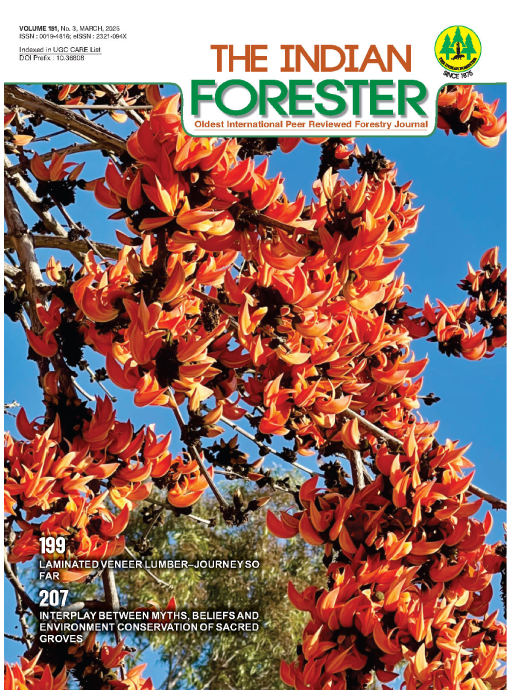Interplay Between Myths, Beliefs and Environment Conservation of Sacred Groves
DOI:
https://doi.org/10.36808/if/2025/v151i3/170454Keywords:
Sacred Grove, Environment Conservation, Seraj.Abstract
The present study was conducted in two sacred groves of Seraj Forest Division, Himachal Pradesh, India, namely Laxmi Narayan Sacred Grove and Pundrik Rishi Lake Sacred Grove. The study's key objective is to highlight the significance of myths and belief systems in environment protection and conservation. Data was collected directly from villagers and various stakeholders to understand myths and beliefs associated with sacred groves. MODIS satellite data has been utilised in Remote sensing and GIS platforms to detect changes in the grove area from 2014 to 2024. Estimating total organic carbon was done using the non-destructive method in 10 m X 10 m sample plots, and carbon stored by Cedrus deodara, the main species of the area, was studied. The study reveals that many myths and beliefs include complete restriction of people's entry into the grove, partial entry allowing only higher caste people, all-time no entry for women, etc. Change detection by RS GIS showed no change in land use in these groves despite increasing habitation in adjoining areas. Carbon Sequestration in Laxmi Narayan sacred grove is about 22.44 tons/100 m2; in Pundrik Rishi grove, it is about 46.32 tons/100 m2.References
Basha S.K.M., Umamaheswari P., Rajyalakshmi E., Rambabu M. and Pullaiah T. (2012). Medicinal fora of Penusila Narasimha sacred grove, eastern Ghats, SPSR Nellore District, Andhra Pradesh, India. Indian J. Fund Appl. Life Sci., 2(2):334–344
Ceperley N., Montagnini F. and Natta A. (2010). Significance of sacred sites for riparian forest conservation in Central Benin. infoscience.epfl.ch. https://infoscience.epfl.ch/entities/publication/cf25fb7c-3e61-4fc7-b714-9803bedc717d
Dafni A. (2007). The supernatural characters and powers of sacred trees in the Holy Land. Journal of Ethnobiology and Ethnomedicine, 3(1). https://doi.org/10.1186/1746-4269-3-10 DOI: https://doi.org/10.1186/1746-4269-3-10
Dar J.A., Subashree K., Raha D., Kumar A., Khare P.K. and Khan M.L. (2019). Tree diversity, biomass and carbon storage in sacred groves of Central India. Environmental Science and Pollution Research, 26(36): 37212–37227. https://doi.org/10.1007/s11356-019-06854-9 DOI: https://doi.org/10.1007/s11356-019-06854-9
Dimri A.P., Niyogi D., Barros A.P., Ridley J., Mohanty U.C., Yasunari T. and Sikka D.R. (2015). Western Disturbances: A review. Reviews of Geophysics, 53(2): 225–246. https://doi.org/10.1002/2014rg000460 DOI: https://doi.org/10.1002/2014RG000460
Gadgil M. and Vartak V.D. (1976). The sacred groves of Western Ghats in India. Economic Botany, 30(2): 152–160. https://doi.org/10.1007/bf02862961 DOI: https://doi.org/10.1007/BF02862961
Handa O.C. (2006). Wood Carving in the Himalayan Region. Indus Publishing Company.
Hegde N. and Joosten H. (2023). The impact of traditional conservation practices on species composition and diversity patterns of sacred swamps in the central Western Ghats, India. Wetlands Ecology and Management, 31(2): 245–266. https://doi.org/10.1007/s11273-023-09914-7 DOI: https://doi.org/10.1007/s11273-023-09914-7
Imarhiagbe O. and Ogwu M.C. (2022). Sacred Groves in the Global South: a panacea for sustainable biodiversity conservation. In Sustainable development and biodiversity (pp. 525–546). https://doi.org/10.1007/978-981-19-3326-4_20 DOI: https://doi.org/10.1007/978-981-19-3326-4_20
Kandari L.S., Bisht V.K., Bhardwaj M. and Thakur A.K. (2014). Conservation and management of sacred groves, myths and beliefs of tribal communities: a case study from north-India. Environmental Systems Research, 3(1). https://doi.org/10.1186/s40068-014-0016-8 DOI: https://doi.org/10.1186/s40068-014-0016-8
Labrecque S., Fournier R., Luther J. and Piercey D. (2006). A comparison of four methods to map biomass from Landsat-TM and inventory data in western Newfoundland. Forest Ecology and Management, 226(1–3): 129–144. https://doi.org/10.1016/j.foreco.2006.01.030 DOI: https://doi.org/10.1016/j.foreco.2006.01.030
Moradi A. and Shabanian N. (2021). Sacred Groves: a pattern of Zagros forests for carbon sequestration and climate change reduction. Research Square (Research Square). https://doi.org/10.21203/rs.3.rs-270508/v1 DOI: https://doi.org/10.21203/rs.3.rs-270508/v2
Rath S. and Ormsby A.A. (2020). Conservation through Traditional Knowledge: a Review of Research on the Sacred Groves of Odisha, India. Human Ecology, 48(4): 455–463. https://doi.org/10.1007/s10745-020-00173-1 DOI: https://doi.org/10.1007/s10745-020-00173-1
Ray R., Chandran M.D.S. and Ramachandra T.V. (2014). Biodiversity and ecological assessments of Indian sacred groves. Journal of Forestry Research, 25(1): 21–28. https://doi.org/10.1007/s11676-014-0429-2 DOI: https://doi.org/10.1007/s11676-014-0429-2
Sharma S. and Kumar R. (2020). Sacred groves of India: repositories of a rich heritage and tools for biodiversity conservation. Journal of Forestry Research, 32(3): 899–916. https://doi.org/10.1007/s11676-020-01183-x DOI: https://doi.org/10.1007/s11676-020-01183-x
Singh H., Agnihotri P., Pande P.C. and Husain T. (2011). Biodiversity conservation through a traditional beliefs system in Indian Himalaya: a case study from Nakuleshwar sacred grove. The Environmentalist, 31(3): 246–253. https://doi.org/10.1007/s10669-011-9329-6 DOI: https://doi.org/10.1007/s10669-011-9329-6
Singh O., Sharma M.C., Sarangi A. and Singh P. (2008). Spatial and temporal variability of sediment and dissolved loads from two alpine watersheds of the Lesser Himalayas. CATENA, 76(1): 27–35. https://doi.org/10.1016/j.catena.2008.08.003 DOI: https://doi.org/10.1016/j.catena.2008.08.003
Singh S., Youssouf M., Malik Z.A. and Bussmann R.W. (2017). Sacred Groves: Myths, Beliefs, and Biodiversity Conservation—A Case Study from Western Himalaya, India. International Journal of Ecology, 1–12. https://doi.org/10.1155/2017/3828609 DOI: https://doi.org/10.1155/2017/3828609
Thaplyal V. and Verma A. (2015). Sacred Groves of Himachal Pradesh: A traditional community practice of biodiversity conservation and testimony of religious beliefs. In Bentham Science Publishers eBooks (pp. 89–96). https://doi.org/10.2174/9781681080215115010010 DOI: https://doi.org/10.2174/9781681080215115010010
Downloads
Downloads
Additional Files
Published
How to Cite
Issue
Section
License
Unless otherwise stated, copyright or similar rights in all materials presented on the site, including graphical images, are owned by Indian Forester.





